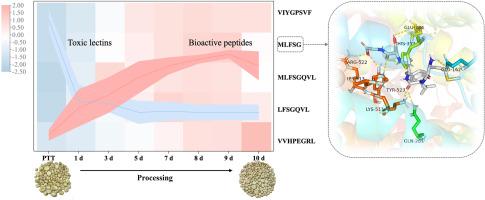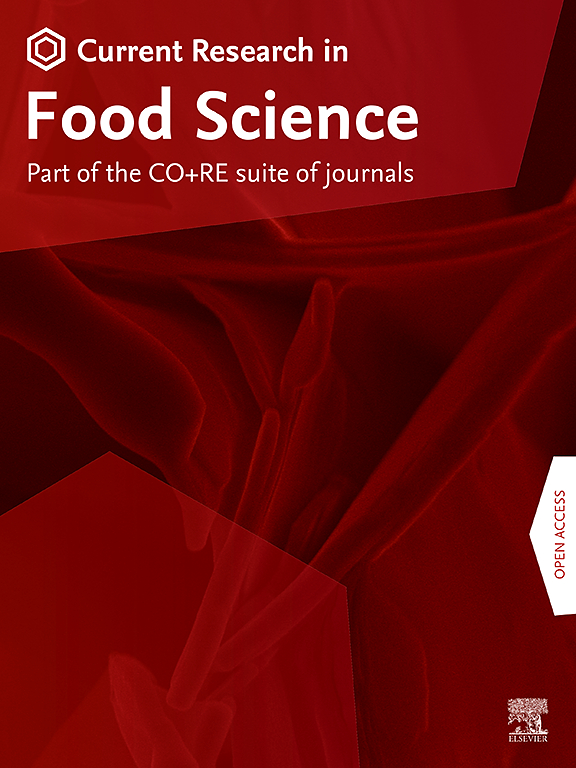Food processing drives the toxic lectin reduction and bioactive peptide enhancement in Pinellia ternata
IF 6.2
2区 农林科学
Q1 FOOD SCIENCE & TECHNOLOGY
引用次数: 0
Abstract
Processing can change the properties and flavors of food. Many plants in the Araceae family can be used as food or medicine, but their raw materials are usually toxic, such as Pinellia ternata tuber (PTT). After processing (processed PTT, PPTT), its toxicity is reduced. However, the mechanism remains unclear. In this study, a novel approach integrating liquid chromatography-mass spectrometry, feature-based molecular networking (FBMN), de novo sequencing, and protein database searching was applied to rapidly discover and characterize peptides in PPTT. Potential antihypertensive peptides were screened using in silico methods, angiotensin I-converting enzyme (ACE) inhibitory assay, and molecular docking analysis. A significant decrease was observed in toxic lectins after processing. Meanwhile, a total of 1954 mass spectral nodes were discovered in PPTT, of which 130 were annotated as peptides by FBMN. These peptides, ranging from 2 to 21 amino acids, were rapidly identified using PEAKS. Notably, 98 peptides were derived from lectins, most of which increased after processing. Approximately 30% of identified peptides were screened for potential high antihypertensive activity in silico. Five peptides exhibited inhibitory effects on ACE, with two showing IC50 values of 131 and 185 μM. Dynamic profiling indicated that 7–9 days of processing is optimal for reducing toxicity and enhancing efficacy. More importantly, these peptides were also found in commercial PPTT, confirming their bioactivity contributions. These findings provide insights into the mechanism by which food processing drives the toxic lectin reduction and bioactive peptide enhancement in PTT, providing a novel approach to rapidly discover bioactive peptides, which can be extended to other foods in Araceae family.

食品加工促进了半夏中有毒凝集素的减少和生物活性肽的增加
加工可以改变食物的性质和味道。许多天南星科植物可用作食品或药物,但其原料通常有毒,如半夏块茎(PTT)。经过加工(加工 PTT,PPTT)后,其毒性会降低。然而,其机理仍不清楚。在这项研究中,我们采用了一种整合了液相色谱-质谱、基于特征的分子网络(FBMN)、从头测序和蛋白质数据库搜索的新方法来快速发现和表征 PPTT 中的多肽。利用硅学方法、血管紧张素I-转化酶(ACE)抑制试验和分子对接分析筛选了潜在的抗高血压多肽。经处理后,毒性凝集素明显减少。同时,在 PPTT 中总共发现了 1954 个质谱节点,其中 130 个被 FBMN 标注为肽。这些肽的氨基酸含量从 2 个氨基酸到 21 个氨基酸不等,并通过 PEAKS 进行了快速鉴定。值得注意的是,98 条肽来自凝集素,其中大部分在加工后有所增加。在已鉴定的肽中,约有 30% 经过了潜在高抗高血压活性的硅学筛选。五种肽对 ACE 具有抑制作用,其中两种肽的 IC50 值分别为 131 和 185 μM。动态分析表明,7-9 天的处理时间是降低毒性和提高疗效的最佳时间。更重要的是,这些肽还出现在商用 PPTT 中,证实了它们对生物活性的贡献。这些发现深入揭示了食品加工过程中减少有毒凝集素和增强PTT中生物活性肽的机制,为快速发现生物活性肽提供了一种新方法,该方法可推广到天南星科的其他食品中。
本文章由计算机程序翻译,如有差异,请以英文原文为准。
求助全文
约1分钟内获得全文
求助全文
来源期刊

Current Research in Food Science
Agricultural and Biological Sciences-Food Science
CiteScore
7.40
自引率
3.20%
发文量
232
审稿时长
84 days
期刊介绍:
Current Research in Food Science is an international peer-reviewed journal dedicated to advancing the breadth of knowledge in the field of food science. It serves as a platform for publishing original research articles and short communications that encompass a wide array of topics, including food chemistry, physics, microbiology, nutrition, nutraceuticals, process and package engineering, materials science, food sustainability, and food security. By covering these diverse areas, the journal aims to provide a comprehensive source of the latest scientific findings and technological advancements that are shaping the future of the food industry. The journal's scope is designed to address the multidisciplinary nature of food science, reflecting its commitment to promoting innovation and ensuring the safety and quality of the food supply.
 求助内容:
求助内容: 应助结果提醒方式:
应助结果提醒方式:


